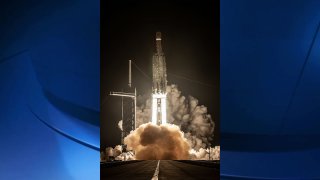
NASA’s experimental Deep Space Atomic Clock is now operating. It completed the commissioning phase of its journey in November.
The instrument is one of several payloads on General Atomics’ Orbital Test Bed satellite (abbreviated OTB), which rode into orbit on a SpaceX Falcon Heavy rocket in June. General Atomics is based in La Jolla. Its Electromagnetic Systems unit, which oversees its satellite business, has its home base in Rancho Bernardo. GA-EMS builds satellites in Colorado.
The Deep Space Atomic Clock (abbreviated DSAC), is an ultra-precise atomic clock designed and built at NASA’s Jet Propulsion Laboratory. If it succeeds during its one year test, it could be the model for clocks that will keep time on journeys to distant planets, perhaps as early as the 2030s.
“OTB continues to operate nominally, and we are excited that DSAC is performing as anticipated,” said Scott Forney, president of General Atomics Electromagnetic Systems, in a statement issued in late December. “We continue to provide operation services to the Jet Propulsion Laboratory and NASA for the currently scheduled year-long trial of DSAC’s functionality and utility for one-way-based space navigation. We are very excited to be supporting a project that has the potential to change the future of deep space navigation.”
Extreme Accuracy
According to NASA, the clock provides extreme accuracy and greater stability than today’s best navigation clocks.
NASA says the instrument is “orders of magnitude more stable than what’s used on spacecraft today.”
Engineers say it will lose less than 1 second in 10 million years. It uses mercury ions; according to NASA, fewer mercury ions than found in two cans of tuna on a supermarket shelf.
Local
Atomic clocks are desirable for keeping time. However, according to NASA, conventional atomic clock designs won’t work in many space flight scenarios; they are too bulky, use too much power and are sensitive to environmental variations. NASA managed to engineer and produce a relatively light, 35-pound atomic clock that fits into a space smaller than 1 cubic foot.
In addition to supporting exploration deeper into the solar system, the clock could potentially provide benefits to Earth users worldwide.
According to a NASA fact sheet, the clock is accurate enough to measure the effects of gravity and relativity on other worlds.
For example, it could measure the effects of Jupiter’s significant gravitational pull on its moons in much less time than required by current approaches. The clock is a project of the NASA Space Technology Mission Directorate’s Technology Demonstration Missions Program.
Other Payloads Aboard
The Orbital Test Bed satellite carries other payloads. Commissioning of each payload continues according to each customer’s schedule.
“We anticipate OTB to remain mission capable for up to seven years, providing customers with a significant timeframe to perform and complete their individual mission objectives,” said Nick Bucci, vice president of Missile Defense and Space Systems at General Atomics Electromagnetic Systems.
The Orbital Test Bed satellite measures approximately 2 by 2 by 3 feet, without its solar panels extended, and it weighs approximately 300 pounds. GA-EMS says it has the capability to build satellites of up to 1,320 pounds, or 600 kilograms.
GA-EMS said it works closely with customers to design and build OTB satellites that simultaneously meet multiple customer mission requirements. In addition, the company provides launch and mission operation services to support the full mission lifecycle for each customer payload.

The Business Journal is the premier business publication in San Diego. Every day online and each Monday in print, the Business Journal reports on how local business operate and why businesses leaders make the decisions they do. Every story is a dose of insight into how to run a better, more efficient, more profitable business.



